The Google Nexus 6P Review
by Andrei Frumusanu on December 16, 2015 8:00 AM ESTSoftware UI
In terms of software the 6P is able to sport the latest Android 6.0 Marshmallow, courtesy of course of being a Nexus device. There’s not terribly much to say about the OS that hasn’t been said already by Brandon’s analysis in the review of the Nexus 5X. This is due to the fact that all Nexus devices come equipped with the same software experience, but also due to the fact that Android 6.0 offers very little front-facing changes.
I’ll openly admit that I’m not too much of a fan of the stock Android experience: Over the years Google’s stock Android has always been praised as the “pure” experience and how Android should be. I find this a bit unfortunate as I find there’s a lot of usability flaws in the stock. It’s the simple things that most other OEM skins add that I find the most lacking in stock Android, examples being the lack of an auto-brightness toggle in the quick settings or even having a brightness slider directly available in the notification shade itself which reduces the motions to get to the settings.
My biggest gripe however are the navigation buttons and Google’s lack of an option to reorder them. While I understand the design decision and logic behind having a back button on the left, it makes no sense in terms of usability for the majority of people that are right-handed. The back button is by far Android’s most used navigation button, so I found the Nexus 6P’s larger size to exacerbate the issue as I need to always change grip or stretch my thumb to able to reach it properly. Still having this huge ergonomics issue after this many years is basically inexcusable – the notion that it’s more intuitive to have it on the left is a poor rationale as “unintuitive” use-methods can be learned and taught, but my thumb stopped growing a long time ago and I imagine so did everybody else’s. Virtually all OEMs recognize this issue and either come by default with reversed navigation buttons or by at least offering the option to rearrange them. Here’s hoping that Google listens and adds this as a stock option for future Android releases, similarly how they did for many other past features that were pioneered by third-party vendors.
Ambient display is a great feature that takes advantage of the 6P's AMOLED screen. Every time you pick up the device it will show you a minimalistic greyed out view of your current notifications without having to press any buttons. The detection is a bit finicky and sometimes goes off too easily as I often saw ambient display trigger itself while the device was just laying steadily on my table, and also sometimes when you do want it to go off when you pick up the device it might decide not to. However when it does work it works well, and it also enables you to directly unlock the phone from there. I do wish the display period had been configurable as sometimes where you have a lot of notifications the screen will go back off before you can read all of them.
Other than some of the aforementioned annoyances, the stock Android experience is a good one. In terms of performance, there were some concerns that I’ll reiterate in the PCMark writing sub-test but otherwise the device is fluid as you’d expect it to be. I may be biased when saying this but I just don’t think stock Android is an “exciting” experience or a platform where we see lots of innovation. I’m aware that there are groups who vehemently adhere to Google’s design decisions, but for me personally it just doesn’t do it as it comes with too many daily usability regressions.
NAND Performance
In terms of NAND storage, the Nexus 6P uses a Samsung eMMC module. In fact, this is the same “BGND3R” variant as found in this year’s HTC One M9. For testing I also ran the NAND benchmarks on an unencrypted data partition to be able to analyze Android’s full disk encryption overhead that is now obligatory for all new devices shipping with 6.0 Marshmallow.
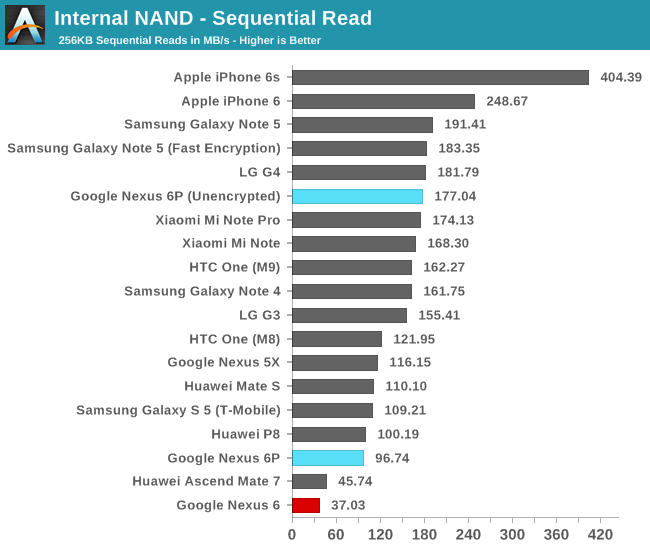
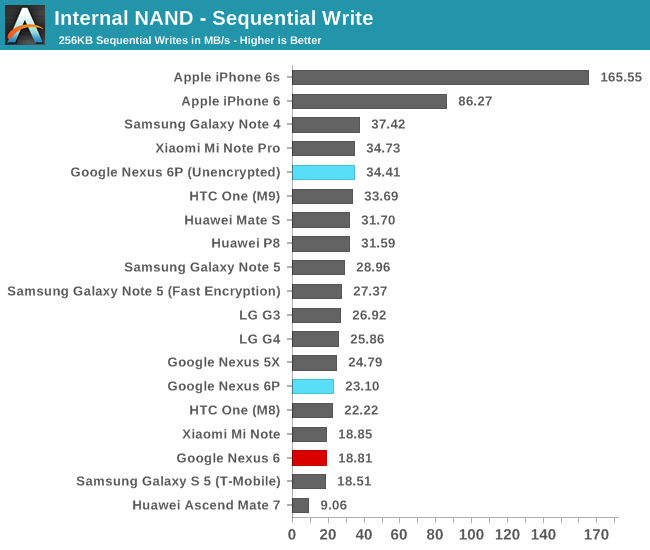
As we can see the unencrypted numbers perform as expected and within range of the HTC One M9’s performance. The encrypted numbers which come as default with the device are the more concerning ones as we see a decrease in read performance of up to 84% and write performance decreases by 43%.
The Nexus 6P uses software decryption, accelerated by ARMv8 cryptography instructions. Google claims that this method is actually faster than using Qualcomm’s Snapdragon built-in SoC dedicated hardware crypto unit, which points out to a possible severe lack of performance and readiness on the part Qualcomm's SoC. We were curious to determine if this was solely an issue for Qualcomm and re-did some encrypted and unencrypted runs on the Note 5 and found that the overhead of encryption on that platform is very minimal, pointing out to that the degradation seems to be limited to Qualcomm's SoCs. It would be interesting to see if the Snapdragon 820 will be able to offer improvements in this regard.
In the end, the Nexus 6P’s out-of-the-box performance on the encrypted data partition seems very lackluster and it may affect application speed. One has to remember that it’s only the data partition that is encrypted, as we see no degradation on the internal or system partitions as they remain unencrypted.
WiFi Performance
The Nexus 6P comes naturally with 802.11ac WiFi in 2x2 MIMO configuration, all powered by Broadcomm's BCM4358 WiFi SoC. This is the same chipset found in other devices such as the Galaxy S6, so hopefully performance will be similar.
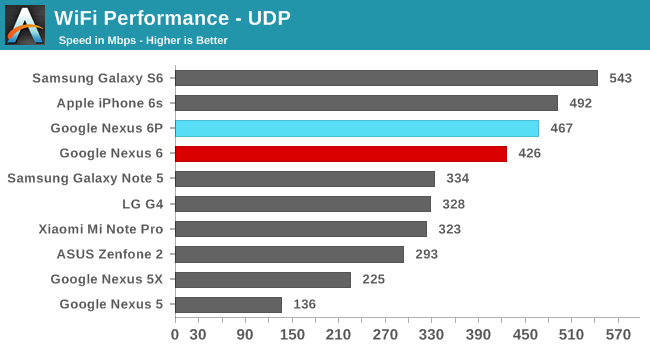
And indeed we see excellent WiFi performance from the 6P as we reach up to an average of 467Mbps, up there among one of the fastest WiFi implementations in today's smartphones.



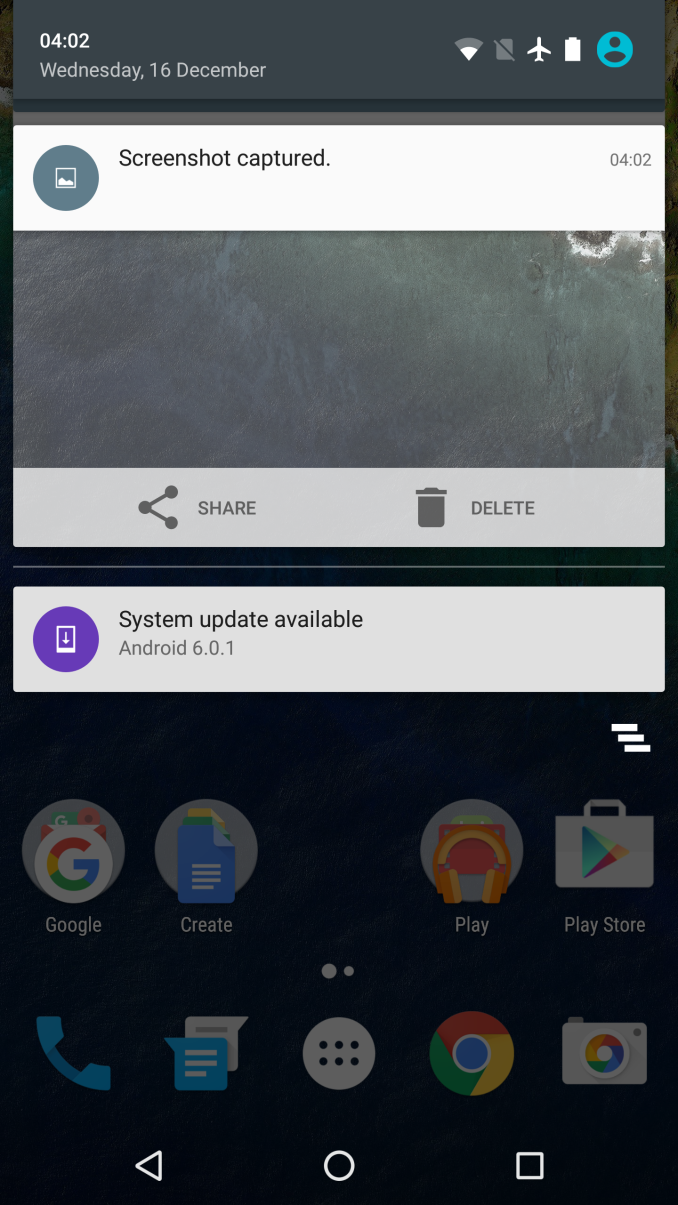
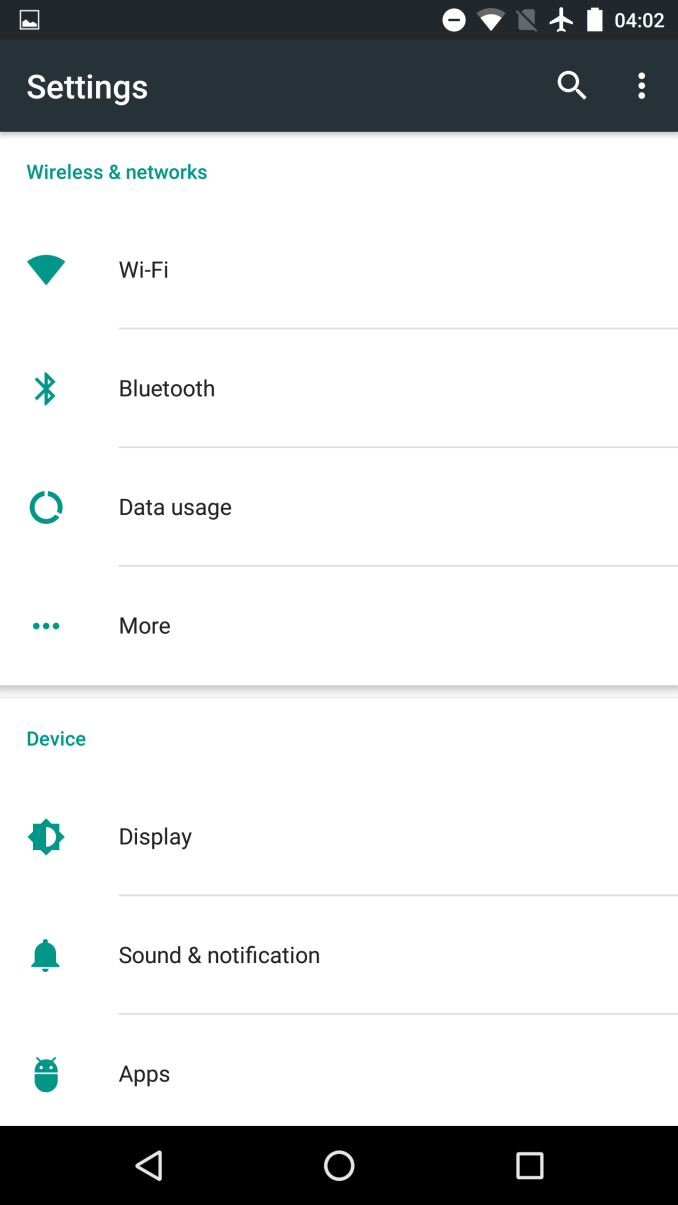









219 Comments
View All Comments
tipoo - Wednesday, December 16, 2015 - link
What was tin hat about that?3DoubleD - Wednesday, December 16, 2015 - link
The problem of competing against the 6S is that Apple was the first to produce a custom 64-bit SoC design on 16 nm FF. Samsung released the first 16 nm FF design, but did so nearly a year ago with a stock BIG.little configuration. They saw massive gains in efficiency purely from the impressive operating voltage and leakage improvements that FF transistors provide. No one else has had access to 16 nm FF until Apple released their 16 nm FF custom SoC. It completely dominates the stock ARM non-16 nm FF SoCs due to design and process advantage and handily beats Samsung's 16 nm FF stock ARM SoC on better design alone.No manufacturer outside of Samsung has the ability to compete with Apple on this level (bleeding edge manufacturing and SoC design), but I can't say Samsung really dropped the ball either. This year's Exynos was plenty fast and efficient to sell premium devices and it performed well against the iPhone 6, which it was in competition with. If only they didn't drop the ball with the small battery capacity they could have had a killer phone.
Next year Samsung won't have the luxury of being the only player with 16 nm FF on Android, so they'll need to step up their game with SoC design, but I don't actually think beating Apple's SoC performance is very important for selling phones. The S6 had great SoC performance and it wasn't an astounding sales success. Thankfully, with 16 nm FF going mainstream next year the rest of us will have access to much more efficient SoCs, even if SoC design continues to stagnate, without the premium price gouging from Apple or Samsung.
grayson_carr - Wednesday, December 16, 2015 - link
Does the benchmark performance of A9 really translate to an improved real world experience though? I still notice that a lot of animations, like the 3D touch menu popping up on the home screen and the app switcher, run at a low framerate on the iPhone 6S Plus (the 6S is much smoother, but it also has a pretty low res screen for 2015). And to me browsing and switching between apps on an iPhone 6S Plus doesn't feel any faster than it does on a Nexus 6P.amdwilliam1985 - Thursday, December 17, 2015 - link
Got a friend who traded in 6+ to 6S+ because he can't handled the lag of iOS9.x, lol, he must be mad...Lavkesh - Thursday, December 17, 2015 - link
The lag has been taken care in the latest release iOS 9.2Djdjndjddjs - Wednesday, December 16, 2015 - link
Subpar hardware? Android has double the screen resolution and a pixel density over 100 pixels better. Then there's the fact they offer more memory at a better price and have better cameras. Saying that the iPhone is better when it still only has a 1080p LCD screen is just ignorant.johnnycanadian - Thursday, December 17, 2015 - link
Heh. Screen resolution? Certainly. More memory? Sure, Android still isn't optimized to the level that iOS is, so it needs it. 2GB is an absolute minimum for 5.x, IMHO. Cameras? Not so much; at best it's a toss-up. And SoC? There's virtually no comparison (the Note5 is the only one that comes close). So yeah, sub-par hardware. I suppose I should have written "Sub-par operating environment" so the OS issues (bloated, unoptimized code) and the less-than-stellar SoC performance would both be taken into account.I'd LOVE to go Android, but until the operating environment can match iOS' I'm stuck with Apple.
grayson_carr - Thursday, December 17, 2015 - link
"2GB is an absolute minimum for 5.x"Is it? My grandmother's Moto G 2015 with only 1 GB of RAM runs great and it's on Android 5.1.
TheinsanegamerN - Monday, December 21, 2015 - link
sending texts and calling her grandchildren are not very demanding. try to browse big websites or play games and that phone will slow to a crawl.tipoo - Tuesday, December 22, 2015 - link
Does your grandmother multitask as much as younger smartphone users? Genuine question. I had a first gen Moto G, I liked it, but the 1GB RAM really started bothering me with every app flip taking time. The third gen one can come with 2GB on the 16GB model, thankfully.On my 6S now, I can't complain about it's 2GB RAM much at all, the only things that reload are usually hours stale anyways.